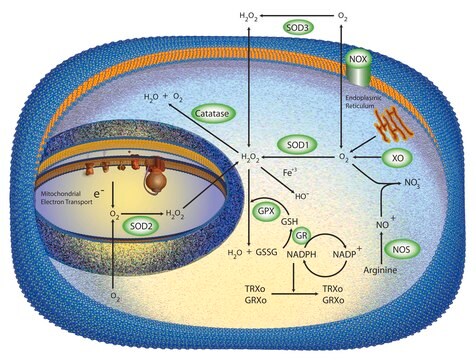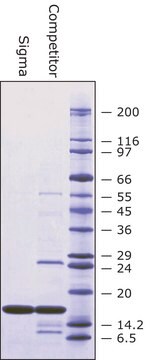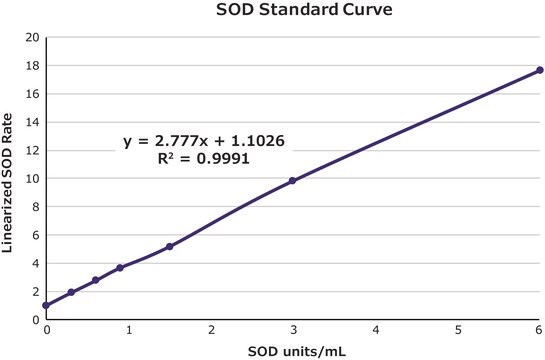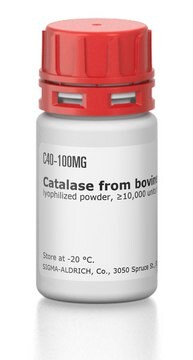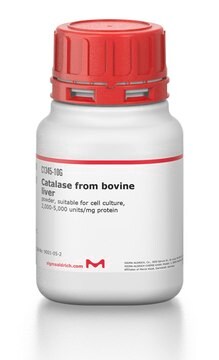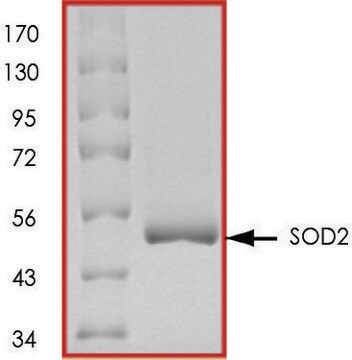S7571
Superoxide Dismutase from bovine erythrocytes
lyophilized powder, ≥3,000 units/mg protein, Protein ≥95 % by biuret
Synonyme(s) :
CU/ZN-SOD, Superoxide Dismutase 1 bovine, cytocuprein, erythrocuprein, hemocuprein, SOD, Superoxide: superoxide oxidoreductase
About This Item
Produits recommandés
Source biologique
bovine
Forme
lyophilized powder
Activité spécifique
≥3,000 units/mg protein
Poids mol.
32.5 kDa
Composition
Protein, ≥95% biuret
Conditions de stockage
(Store under nitrogen.
Tightly closed. Dry.)
Caractéristiques du produit alternatif plus écologique
Atom Economy
Design for Energy Efficiency
Use of Renewable Feedstocks
Learn more about the Principles of Green Chemistry.
sustainability
Greener Alternative Product
Technique(s)
immunoblotting: suitable
inhibition assay: suitable
Couleur
blue-green
pl
4.95
Solubilité
water: 20 mg/mL
aqueous buffer, pH 7.5: soluble
Application(s)
diagnostic assay manufacturing
Autre catégorie plus écologique
Température de stockage
−20°C
Informations sur le gène
cow ... SOD1(281495) , SOD2(281496)
Vous recherchez des produits similaires ? Visite Guide de comparaison des produits
Catégories apparentées
Description générale
Superoxide dismutase (SOD) is a redox-active metalloenzyme expressed in both aerobic and anaerobic living organisms. Bovine superoxide dismutase or CuZn SOD is a homodimer with each subunit containing one zinc and one copper ion.
Application
- in a study to assess a kinetic model of radiation-induced inactivation of superoxide dismutase in nitrous oxide-saturated solutions
- in a study to investigate the possible participation of superoxide anion in the intestinal tryptophan 2,3-dioxygenase reaction
- to investigate its effect on the hemolysis rate of human RBCs and hemoglobin-nitric oxide complex (HbNO) stability in human erythrocytes
- in combination with catalase to study its effect on cell differentiation in vitro
- to quantify superoxide levels and study their effect on reactivity in mouse pulmonary arteries through chemiluminescence and cytochrome C reduction methods
Actions biochimiques/physiologiques
Définition de l'unité
Forme physique
Application
Produit(s) apparenté(s)
Mention d'avertissement
Danger
Mentions de danger
Conseils de prudence
Classification des risques
Resp. Sens. 1
Code de la classe de stockage
11 - Combustible Solids
Classe de danger pour l'eau (WGK)
WGK 1
Point d'éclair (°F)
Not applicable
Point d'éclair (°C)
Not applicable
Équipement de protection individuelle
Eyeshields, Gloves, type N95 (US)
Faites votre choix parmi les versions les plus récentes :
Déjà en possession de ce produit ?
Retrouvez la documentation relative aux produits que vous avez récemment achetés dans la Bibliothèque de documents.
Les clients ont également consulté
Articles
Oxidative stress is mediated, in part, by reactive oxygen species produced by multiple cellular processes and controlled by cellular antioxidant mechanisms such as enzymatic scavengers or antioxidant modulators. Free radicals, such as reactive oxygen species, cause cellular damage via cellular.
Protocoles
Enzymatic Assay of Superoxide Dismutase
Separation of Superoxide dismutase
Chromatograms
application for HPLCNotre équipe de scientifiques dispose d'une expérience dans tous les secteurs de la recherche, notamment en sciences de la vie, science des matériaux, synthèse chimique, chromatographie, analyse et dans de nombreux autres domaines..
Contacter notre Service technique